Mortar (weapon)
This articleneeds additional citations forverification.(August 2023) |
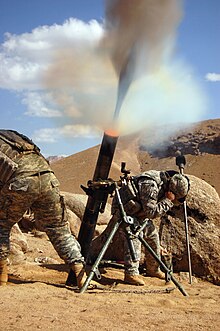
| Part of a series on |
| Cannons |
|---|
 |
Amortartoday is usually a simple, lightweight, man-portable,muzzle-loadedcannon,consisting of asmooth-bore(although some models use arifled barrel) metal tube fixed to a base plate (to spread out therecoil) with a lightweightbipodmount and asight.Mortars are typically used asindirect fireweapons for closefire supportwith a variety of ammunition. Historically mortars were heavysiege artillery.Mortars launch explosiveshells(technically called bombs)[1]in high-archingballistic trajectories.
History[edit]
Mortars have been used for hundreds of years. The earliest reported use of mortars were in Korea in a 1413 naval battle when Korean gunsmiths developed thewan'gu(gourd-shaped mortar) (완구, oản khẩu ).[2]The earliest version of thewan'gudates back to 1407.[3]Ch'oe Hae-san(1380–1443), the son ofCh'oe Mu-sŏn(1325–1395), is generally credited with inventing thewan'gu.[4]In theMing dynasty,generalQi Jiguangrecorded the use of a mini cannon called thehu dun paothat was similar to the mortar.[5]
The first use insiege warfarewas at the1453 siege of ConstantinoplebyMehmed the Conqueror.An Italian account of the1456 siege of Belgradeby Giovanni da Tagliacozzo states that theOttoman Turksused seven mortars that fired "stone shots oneItalian milehigh ".[6]The time of flight of these was apparently long enough that casualties could be avoided by posting observers to give warning of their trajectories.[7]

Early mortars, such as thePumhart von Steyr,were large and heavy and could not be easily transported. Simply made, these weapons were no more than iron bowls reminiscent of the kitchen and apothecarymortarswhence they drew their name. An early transportable mortar was invented by BaronMenno van Coehoornin 1701.[8][9]This mortar fired an exploding shell, which had afusethat was lit by the hot gases when fired. TheCoehornmortar gained quick popularity, necessitating a new form of naval ship, thebomb vessel.Mortars played a significant role in the Venetian conquest ofMorea,and in the course of this campaign anammunition depotin theParthenonwas blown up. An early use of these more mobile mortars asfield artillery(rather thansiege artillery) was by British forces in the suppression of theJacobite rising of 1719at theBattle of Glen Shiel.High angle trajectory mortars held a great advantage over standardfield gunsin the rough terrain of theWest Highlandsof Scotland.

The mortar had fallen out of general use in Europe by theNapoleonic era,althoughManby Mortarswere widely used on the coast to launch lines to ships in distress, and interest in their use as a weapon was not revived until the beginning of the 20th century. Mortars were heavily used by both sides during theAmerican Civil War.At theSiege of Vicksburg,GeneralUlysses S. Grantreported making mortars "by taking logs of the toughest wood that could be found, boring them out for 6 or 12 lb (2.7 or 5.4 kg) shells and binding them with strong iron bands. These answered asCoehorns,and shells were successfully thrown from them into the trenches of the enemy ".[10]
During theRusso-Japanese War,Lieutenant GeneralLeonid Gobyatoof theImperial Russian Armyapplied the principles ofindirect firefrom closed firing positions in the field; and with the collaboration of GeneralRoman Kondratenko,he designed the first mortar that fired navy shells.

TheGerman Armystudied theSiege of Port Arthur,where heavy artillery had been unable to destroy defensive structures like barbed wire and bunkers. Consequently they developed a short-barrelled rifled muzzle-loading mortar called theMinenwerfer.Heavily used duringWorld War I,they were made in three sizes: 7.58 cm (2.98 in), 17 cm (6.7 in), and 25 cm (9.8 in).
Types[edit]
Stokes mortar[edit]
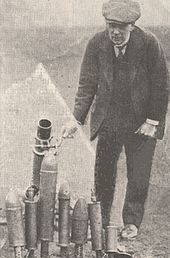
It was not until theStokes mortarwas devised by SirWilfred Stokesin 1915 during the First World War that the modern mortar transportable by one person was born. In the conditions oftrench warfare,there was a great need for a versatile and easily portable weapon that could be manned by troops under cover in the trenches. Stokes' design was initially rejected in June 1915 because it was unable to use existing stocks of British mortar ammunition, and it took the intervention ofDavid Lloyd George(at that timeMinister of Munitions) and Lieutenant Colonel J. C. Matheson of the Trench Warfare Supply Department (who reported to Lloyd George) to expedite manufacture of the Stokes mortar. The weapon proved to be extremely useful in the muddy trenches of theWestern Front,as a mortar round could be aimed to fall directly intotrenches,where artillery shells, because of their low angle of flight, could not possibly go.[11]
The Stokes mortar was a simple muzzle-loaded weapon, consisting of a smoothbore metal tube fixed to a base plate (to absorb recoil) with a lightweightbipodmount. When a mortar bomb was dropped into the tube, an impact sensitiveprimerin the base of the bomb would make contact with a firing pin at the base of the tube and detonate, firing the bomb towards the target. The Stokes mortar could fire as many as 25 bombs per minute and had a maximum range of 800 yd (730 m), firing the original cylindrical unstabilised projectile.[12]
A modified version of the mortar, which fired a modernfin-stabilisedstreamlinedprojectileand had a booster charge for longer range, was developed after World War I;[13]this was in effect a new weapon. By World War II, it could fire as many as 30 bombs per minute and had a range of over 2,500 yd (2,300 m) with some shell types.[14]The French developed an improved version of the Stokes mortar as theBrandt Mle 27,further refined as theBrandt Mle 31;this design was widely copied with and without license.[15][16][17]These weapons were the prototypes for all subsequent light mortar developments around the world.
Mortar carrier[edit]
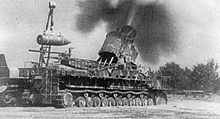

Mortar carriersare vehicles which carry a mortar as a primary weapon. Numerous vehicles have been used to mount mortars, fromimprovised civilian trucksused byinsurgents,to modifiedinfantry fighting vehicles,such as variants of theM3 half-trackandM113 armored personnel carrier,to vehicles specifically intended to carry a mortar. Simpler vehicles carry a standard infantry mortar while in more complex vehicles the mortar is fully integrated into the vehicle and cannot be dismounted from the vehicle. Mortar carriers cannot be fired while on the move, and some must be dismounted to fire.
There are numerousarmoured fighting vehiclesand evenmain battle tanksthat can be equipped with a mortar, either outside or inside of the cabin. The IsraeliMerkavatank uses a 60 mm (2.4 in) mortar as a secondary armament. TheRussian armyuses the2S4 Tyulpanself-propelled 240 mm (9.4 in) heavy mortar which is one of the largest mortars in current use.
Gun-mortars[edit]

Gun-mortars are breech-loaded mortars usually equipped with ahydraulic recoil mechanism,and sometimes equipped with anautoloader.They are usually mounted on an armoured vehicle and are capable of bothdirect fireandindirect fire.The archetypes are theBrandt Mle CM60A1andBrandt 60 mm LR,which combine features of modern infantry mortars together with those of modern cannon. Such weapons are most commonly smoothbore, firing fin-stabilised rounds, using relatively small propellant charges in comparison to projectile weight. While some have been fitted with rifled barrels, such as the2S31 Venaand2S9 Nona.They have short barrels in comparison to guns and are much more lightly built than guns of a similar calibre – all characteristics of infantry mortars. This produces a hybrid weapon capable of engaging area targets with indirect high-angle fire, and also specific targets such as vehicles and bunkers with direct fire. Such hybrids are much heavier and more complicated than infantry mortars, superior torocket-propelled grenadesin the anti-armour andbunker-bustingrole, but have a reduced range compared to modern gun-howitzersand inferior anti-tank capability compared to modern anti-tankguided weapons.However, they do have a niche in, for example, providing a multi-role anti-personnel, anti-armour capability in light mobile formations. Such systems, like the Soviet 120 mm2S9 Nona,are mostly self-propelled (although a towed variant exists). TheAMOS(Advanced Mortar System) is an example of an even more advanced gun mortar system. It uses a 120 mm automatic twin-barrelled, breech-loaded mortar turret, which can be mounted on a variety of armoured vehicles and attack boats. A modern example of a gun-mortar is the2B9 Vasilek.
Spigot mortar[edit]
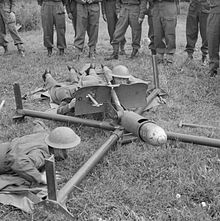
A spigot mortar consists mainly of a solid rod orspigot,onto which a hollow tube in the projectile fits—inverting the normal tube-mortar arrangement. At the top of the tube in the projectile, a cavity containspropellant,such ascordite.There is usually a trigger mechanism built into the base of the spigot, with a long firing pin running up the length of the spigot activating aprimerinside the projectile and firing the propellant charge. The advantage of a spigot mortar is that the firing unit (baseplate and spigot) is smaller and lighter than a conventional tube mortar of equivalent payload and range. It is also somewhat simpler to manufacture. Further, most spigot mortars have no barrel in the conventional sense, which means ammunition of almost any weight and diameter can be fired from the same mortar.
The disadvantage is that while most mortar bombs have a streamlined shape towards the back that fits a spigot mortar application well, using that space for the spigot mortar tube takes volume and mass away from the payload of the projectile. If a soldier is carrying only a few projectiles, the projectile weight disadvantage is not significant. However, the weight of a large quantity of the heavier and more complex spigot projectiles offsets the weight saved.
A near-silent mortar can operate using the spigot principle. Each round has a close-fitting sliding plug in the tube that fits over the spigot. When the round is fired, the projectile is pushed off the spigot, but before the plug clears the spigot it is caught by a constriction at the base of the tube. This traps the gases from the propelling charge and hence the sound of the firing. After World War II the Belgium Fly-K silent spigot mortar was accepted into French service as the TN-8111.[18][19]
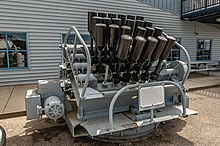
Spigot mortars generally fell out of favour after World War II and were replaced by smaller conventional mortars. Military applications of spigot mortars include:
- The 230 mm (9.1 in) petard mortar used on theChurchill AVREby Britain in World War II.[20]
- The320 mm (13 in) Type 98 mortarused by Japan in World War II to some psychological effect in the battles ofIwo JimaandOkinawa
- TheBlacker BombardandPIATanti-tank launchers used by Britain in World War II.
- TheHedgehoglauncher, used from the deck of a ship, used 24 spigot mortars which fired a diamond pattern of anti-submarine projectiles into the sea ahead of the ship. A sinking projectile detonated if it struck a submarine, and the pattern was such that any submarine partly in the landing zone of the projectiles would be struck one or more times.
Non-military applications include the use of small-calibre spigot mortars to launch lightweight, low-velocity foam dummy targets used for trainingretrieverdogs for bird hunting. Simple launchers use a separate small primer cap as the sole propellant (similar or identical to the cartridges used in industrialnail guns).
Improvised[edit]

Insurgent groups often use improvised, or "homemade" mortars to attack fortified military installations or terrorise civilians. They are usually constructed from heavy steel piping mounted on a steel frame. These weapons may fire standard mortar rounds, purpose-made shells, repurposed gas cylinders filled with explosives and shrapnel, or any other type of improvised explosive, incendiary or chemical munitions. These were called "barrack busters"by theProvisional Irish Republican Army (PIRA).
Syrian civil war[edit]
Improvised mortars used by insurgents in theSyrian civil warare known ashell cannons.Observers have noted that they are "wildly inaccurate" and responsible for hundreds of civilian deaths.[21]
Sri Lankan civil war[edit]
Improvised mortars used in theSri Lankan civil warby the rebelTamil Tigersare known as "Pasilan 2000", also known as a "rocket mortar" or "Arti-mortar" like the 122 mm (4.8 in) cannon, successor to theBaba mortarused by the LTTE for ground operations since the 1980s. As Baba mortar rounds contained tar, they caused a fire when they hit the ground.[22]The Baba, the prototype mortar, was crude. But with time the weapon has improved.
The Pasilan 2000, the improved version, has been developed with characteristics similar to a rocket launcher. The Pasilan 2000 was a heavy mortar fired from a mobile launcher mounted on a tractor. The shell does not emit constant muzzle flares likeartilleryor MBRL. This is ideal for LTTE's camouflage and conceals attacking style. Once a round is fired, forward observers/spies/civilian spotters can correct the fire. The way the tube is installed is similar to the positioning of rocket pods. The length and calibre of the barrel indicate Pasilan 2000 system has common features to the Chinese made Type 82 130 mm (5.1 in) 30-tube MLRS (introduced by the Palestinian Liberation Army (PLA) in the early 1980s) rather than rail-guided Katyusha variants such as the Qassam Rocket. The warhead weight is 70 kg (150 lb) and it is filled with TNT. It had a range of 15 to 25 km (9.3 to 15.5 mi). The rocket has since then undergone some modifications. The Pasilan 2000 was more lethal than Baba mortar. But it was not heavily used for ground attacks during theEelam War IV.[23][24]
Modern[edit]
Design[edit]
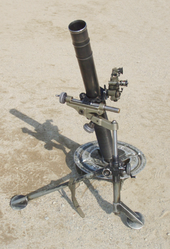

Most modern mortar systems consist of four main components: a barrel, a base plate, a bipod and a sight. Modern mortars normally range incalibrefrom 60 mm (2.36 in) to 120 mm (4.72 in). However, both larger and smaller mortars have been produced. The modern mortar is a muzzle-loaded weapon and relatively simple to operate. It consists of a barrel into which the gunners drop a mortar round. When the round reaches the base of the barrel it hits a fixedfiring pinthat fires the round. The barrel is generally set at an angle of between 45 and 85 degrees (800 to 1500 mils), with the higher angle producing a shorter horizontal trajectory. Some mortars have a moving firing pin, operated by alanyardortrigger mechanism.
Ammunition[edit]

Ammunitionfor mortars generally comes in two main varieties: fin-stabilised and spin-stabilised. Examples of the former have short fins on their posterior portion, which control the path of the bomb in flight. Spin-stabilised mortar bombs rotate as they travel along and leave the mortar tube, which stabilises them in much the same way as a rifle bullet. Both types of rounds can be eitherillumination(infraredor visible illumination),smoke,high explosive,and training rounds. Mortar bombs are often referred to, incorrectly, as "mortars".[25]
Operators may fire spin-stabilised rounds from either a smoothbore or a rifled barrel. Rifled mortars are more accurate but slower to load. Since mortars are generally muzzle-loaded, mortar bombs for rifled barrels usually have a pre-engraved band, called an obturator, that engages with the rifling of the barrel. Exceptions to this were the U.S.M2 4.2-inch mortarandM30 mortar,whose ammunition had a sub-calibre expandable ring that enlarged when fired. This allows the projectile to slide down the barrel freely but grip the rifling when fired. The system resembles theMinié ballfor muzzle-loading rifles. For extra range, propellant rings (augmentation charges) are attached to the bomb's fins. The rings are usually easy to remove, because they have a major influence on the speed and thus the range of the bomb. Some mortar rounds can be fired without any augmentation charges, e.g., the81 mm L16 mortar.
| Charge | Muzzle Velocity m/s (ft/s) |
Range m (yd) |
|---|---|---|
| Primary | 73 (240) | 180–520 (200–570) |
| Charge 1 | 110 (360) | 390–1,120 (430–1,220) |
| Charge 2 | 137 (450) | 580–1,710 (630–1,870) |
| Charge 3 | 162 (530) | 780–2,265 (853–2,477) |
| Charge 4 | 195 (640) | 1,070–3,080 (1,170–3,370) |
| Charge 5 | 224 (730) | 1,340–3,850 (1,470–4,210) |
| Charge 6 | 250 (820) | 1,700–4,680 (1,860–5,120) |
Precision guided[edit]

TheXM395 Precision Guided Mortar Munition (PGMM)is a 120 mmguidedmortar round developed byAlliant Techsystems.[27]Based on Orbital ATK's Precision Guidance Kit for 155 mm artillery projectiles, XM395 combinesGPSguidance and directional control surfaces into a package that replaces standard fuses, transforming existing 120 mm mortar bodies into precision-guided munitions.[28]The XM395 munition consists of a GPS-guided kit fitted to standard 120 mm smoothbore mortar rounds that includes the fitting of a nose and tail subsystem containing the maneuvering parts.[29][30]
TheStrix mortar roundis a Swedish endphase-guided projectile fired from a 120 mm mortar currently manufactured bySaab Bofors Dynamics.STRIX is fired like a conventional mortar round. The round contains aninfraredimaging sensor that it uses to guide itself onto any tank or armoured fighting vehicle in the vicinity where it lands. The seeker is designed to ignore targets that are already burning. Launched from any 120 mm mortar, STRIX has a normal range of up to 4.5 km (2.8 mi). The addition of a special sustainer motor increases the range to 7.5 km (4.7 mi).
TheGMM 120(Guided Mortar Munition 120;known asPatzmi;also referred to asMorty) is a GPS and/orlaser-guided mortar munition, which was developed byIsrael Military Industries.[31][32]Another Israeli guided mortar isIron Sting,developed byElbit.The RussianKM-8 Granis also laser-guided.[33]
Compared to long range artillery[edit]

Modern mortars and their ammunition are generally much smaller and lighter than long rangeartillery,such asfield gunsandhowitzers,which allows light (60 mm (2.4 in)) and medium (81 mm (3.2 in)/82 mm (3.2 in)) mortars to be considered light weapons; i.e. capable of transport by personnel without vehicle assistance.
Mortars are short-range weapons and often more effective than long range artillery for many purposes within their shorter range. In particular, because of its high,parabolic trajectorywith a near vertical descent, the mortar can land bombs on nearby targets, including those behind obstacles or infortifications,such as light vehicles behind hills or structures, or infantry intrenchesorspider holes.This also makes it possible to launch attacks from positions lower than the target of the attack. (For example, long-range artillery could not shell a target 1 km (0.62 mi) away and 30 m (98 ft) higher, a target easily accessible to a mortar.)
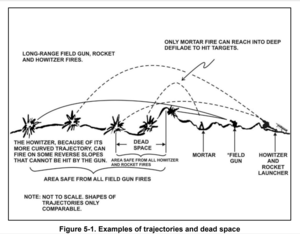
Intrench warfare,mortars can useplunging firedirectly into the enemytrenches,which is very hard or impossible to accomplish with long range artillery because of its much flatter trajectory. Mortars are also highly effective when used from concealed positions, such as the natural escarpments on hillsides or from woods, especially ifforward observersare being employed in strategic positions to direct fire, an arrangement where the mortar is in relatively close proximity both to its forward observer and its target, allowing for fire to be quickly and accurately delivered with lethal effect. Mortars suffer from instability when used on snow or soft ground, because the recoil pushes them into the ground or snow unevenly. ARaschen bagaddresses this problem.
Fin-stabilised mortar bombs do not have to withstand therotational forcesplaced upon them by rifling or greater pressures, and can therefore carry a higherpayloadin a thinner skin than rifled artillery ammunition. Because of the difference in available volume, a smooth-bore mortar of a given diameter will have a greater explosive yield than a similarly sized artillery shell of a gun or howitzer. For example, a 120 mm mortar bomb has approximately the same explosive capability as a 152 mm/155 mm artillery shell. Also, fin-stabilised munitions fired from a smooth-bore, which do not rely on the spin imparted by a rifled bore for greater accuracy, do not have the drawback of veering in the direction of the spin.
Largest mortars[edit]
From the 17th to the mid-20th century, very heavy, relatively immobile siege mortars were used, of up to 1 m (3 ft 3 in) calibre, often made of cast iron and with an outside barrel diameter many times that of the bore diameter. An early example wasRoaring Meg,with a 15.5 in (390 mm) barrel diameter and firing a 220 lb (100 kg) hollow ball filled with gunpowder and used during theEnglish Civil Warin 1646.
The largest mortars ever developed were the Belgian "Monster Mortar"(24 in (610 mm)) developed byHenri-Joseph Paixhansin 1832,Mallet's Mortar(36 in (910 mm)) developed byRobert Malletin 1857, and the "Little David"((36 in (910 mm)) developed in the United States for use in World War II. Although the latter two had a calibre of 36 in (910 mm), only the" Monster Mortar "was used in combat (at theBattle of Antwerpin 1832).[34]The World War II GermanKarl-Gerätwas a 60 cm (24 in) mortar and the largest to see combat in modern warfare.
-
Roaring Meg on display at Goodrich Castle
-
World War II US Army movie footage of the 914 mm "Little David" mortar
See also[edit]
- Carcass (projectile),used in mortars before the modern age
- Chemical mortar battalion
- Coehorna lightweight mortar, sometimes improvised
- Eprouvette,a mortar used to test the strength of gunpowder
- List of heavy mortars
- List of infantry mortars
- Livens Projector
References[edit]
- ^"mortar definition".Oxford Dictionary of English.Oxford University Press. Archived fromthe originalon October 9, 2019.Retrieved10 October2019.
- ^Stephen Turnbull (2002).Siege Weapons of the Far East (2): AD 960–1644.Osprey Publishing. p. 13.ISBN978-1-841-76340-8.
- ^"Toys".Culturecontent.com.Archived fromthe originalon 10 October 2017.Retrieved19 November2017.
- ^"대완구".Data.kdata.kr.Archived fromthe originalon 1 December 2017.Retrieved19 November2017.
- ^Needham, Joseph(1987).Science and Civilisation in China.Volume 5. Chemistry and Chemical Technology. Part 7. Military Technology: The Gunpowder Epic.Cambridge:Cambridge University Press.p. 313.ISBN9780521303583.
- ^Gábor Ágoston (2005).Guns for the Sultan: Military Power and the Weapons Industry in the Ottoman Empire.Cambridge University Press. p. 68.ISBN978-0-521-84313-3.
- ^Franz Babinger (1992).Mehmed the Conqueror and His Time.Princeton University Press. p. 140.ISBN978-0-691-01078-6.
- ^Chisholm, Hugh,ed. (1911)..Encyclopædia Britannica.Vol. 8 (11th ed.). Cambridge University Press. p. 40.
- ^Duffy, Christopher (1985).The Fortress in the Age of Vauban and Frederick the Great 1660–1789(2017 ed.). Routledge. p. 65.ISBN1138924644.
- ^Personal Memoirs of Ulysses S Grant,by Sam Grant, Kindle location 12783,
- ^naval-military-press.com[dead link]
- ^"Stokes Mortar - by WL Ruffell".Archived fromthe originalon 2015-01-15.Retrieved2014-07-17.
- ^Ruffell
- ^War Dept. Technical Manual TM9-2005, Volume 3, Ordnance Materiel – General, Page 17, December 1942
- ^Chris Bishop (2002).The Encyclopedia of Weapons of World War II.Sterling Publishing Company. p. 202.ISBN978-1-58663-762-0.Archivedfrom the original on 2015-03-20.Retrieved2016-03-27.
- ^"Brandt mle 27 (Mortier Brandt de 81 mm modele 27)Infantry Mortar ".Militaryfactory.com.Archivedfrom the original on 1 December 2017.Retrieved19 November2017.
- ^John Norris (2002).Infantry Mortars of World War II.Osprey Publishing. pp. 42–43.ISBN978-1-84176-414-6.Archivedfrom the original on 2015-03-20.Retrieved2016-03-27.
- ^"A Second Wind For The Lightweight Infantry Mortar",thinkdefence.co.uk,July 19, 2021
- ^Fly-K mortar systems – excellent stealth capabilities and tremendous tactical potential,archived fromthe originalon 2023-03-14
- ^"Tank Hurls Flying Dust Bins and Lays Tracks",Popular Mechanics,Hearst Magazines, p. 7, December 1944
- ^Oliver Holmes (December 12, 2014)."Syrian rebel" hell cannons "kill 300 civilians: monitoring group".Reuters.Yahoo! News.Archivedfrom the original on December 16, 2014.RetrievedDecember 13,2014.
- ^"Forign1".
- ^"Pasilan 2000 used by the LTTE".
- ^"Dossier on LTTE Weapons – PDF document".
- ^Slough observer:Suspected Second World War mortar exploded in Windsor today, 3 October 2014.Example of use of the word "mortar" for a mortar bomb
- ^Hogg, Ian V.:The Illustrated Encyclopedia of Ammunition,p. 126
- ^"Alliant Techsystems Takes Army Mortar Contract (Again)".Defense Industry Daily.Dec 7, 2004. Archived fromthe originalon 2006-03-18.Retrieved2018-06-11.
- ^"XM395 Precision Mortar (120mm)".Northrop Grumman.Archived fromthe originalon 2017-09-10.Retrieved2018-06-11.
- ^Calloway, Audra (29 March 2011)."Picatinny fields first precision-guided mortars to troops in Afghanistan".Army.mil.Archivedfrom the original on 2016-12-30.
- ^"XM395: 120 mm Precision Mortar"(PDF).ATK Advanced Weapon.ATK.Retrieved21 February2012.[dead link]
- ^"GMM 120–120 mm Guided Mortar Munition".Israel Military Industries.Archivedfrom the original on 7 April 2014.Retrieved6 April2014.
- ^"Israeli army tests GPS-guided mortar shell".i24news.Archived fromthe originalon 2014-04-07.Retrieved6 April2014.
- ^""MALAKHIT" AUTOMATED ARTILLERY FIRE CONTROL SYSTEM ".KBP Instrument Design Bureau.Archived fromthe originalon 2 November 2019.Retrieved8 May2020.
- ^"Largest Mortar".Guinness World Records.Archived fromthe originalon 2006-02-10.Retrieved2006-04-04.
External links[edit]
- A Guide to Modern Mortar Systems
- "Field Manual 3-22.90 – Mortars"(PDF).Department of the Army. December 2007. Archived fromthe original(PDF)on 17 February 2013.Retrieved7 January2013.
- "Field Manual 3-22.91 – Mortar Fire Direction Procedures"(PDF).Department of the Army. 17 July 2008. Archived fromthe original(PDF)on 17 February 2013.Retrieved7 January2013.
- "Field Manual 23-91 – Mortar Gunnery"(PDF).Department of the Army. 1 March 2000.Retrieved7 January2013.
- Mallet's Mortar, the largest British mortar ever made
- Defense Update: Modern mobile 120 mm mortars
- Defense Update: Advanced mortar munitions
- How does a mortar work? – video
- Mortars during World War I
- TheKarl Morser,WW II-era German 60 cm self-propelled mortar
- Video(streaming wmv)

